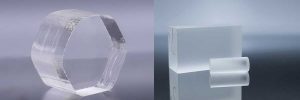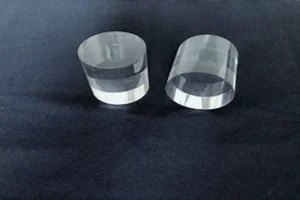Introduction
The technological world continues to evolve, with laser technology playing a pivotal role in various fields, including medical, industrial, and scientific research. The heart of every laser system is its lasing medium, a material that emits light in response to external stimuli. In this article, we delve into three different laser crystals – Ti:sapphire, Yb:KGW, and Yb:KYW – analyzing their capabilities and performance in ultrashort pulse laser systems.
Performance and Capabilities of Titanium Sapphire (Ti:sapphire)
The Ti:sapphire crystal continues to occupy a distinguished position in the ultrashort pulse generation field, particularly excelling in femtosecond lasers. The crystal’s ubiquitous presence in such laser systems can be attributed to its unique features, which align perfectly with the requirements for ultrashort pulse generation.
One of the most important attributes of Ti:sapphire is its considerable gain bandwidth. The gain bandwidth is a measure of a lasing medium’s ability to amplify a broad range of frequencies, and in the case of Ti:sapphire, this is a particularly broad range. This broad gain bandwidth allows the generation of extremely short pulses, which are of paramount importance in applications like ultrafast spectroscopy, micromachining, and medical imaging.
Another characteristic of Ti:sapphire that adds to its appeal is its broad tunability. The tunability range of Ti:sapphire extends from 650 nm to 1100 nm. This broad spectrum ensures that Ti:sapphire-based lasers can be used in a wide variety of applications, as it can be tuned to the most effective wavelength for a specific task.

However, despite these advantages, the use of Ti:sapphire is not without its challenges. Producing high pulse repetition rates and substantial output power, as is required in many applications, necessitates significant pump power. This, in turn, generates heat within the lasing system, which must be effectively managed to maintain the longevity and efficiency of the system. Thus, while Ti:sapphire is undoubtedly an effective medium for ultrashort pulse generation, considerations must be made regarding its thermal management when designing laser systems around this crystal.
In conclusion, while Ti:sapphire poses certain challenges in terms of thermal management, its exceptional gain bandwidth and broad tunability make it a preferred choice for ultrashort pulse generation. Its versatility and capability ensure that Ti:sapphire will remain a cornerstone in the world of ultrafast lasers.
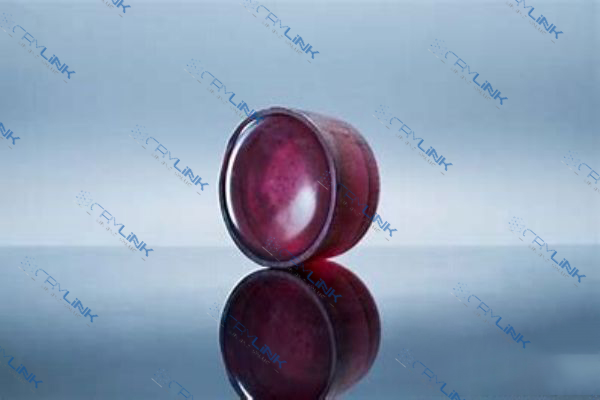
Ytterbium-Doped Potassium Gadolinium Tungstate (Yb:KGW)
Yb:KGW, or Ytterbium-Doped Potassium Gadolinium Tungstate, is a prominent player in the field of ultrashort pulse generation. Its favorable thermal conductivity positions it as a potent candidate for high-power applications, where managing heat accumulation is critical.
Yb:KGW’s wide emission cross-section is instrumental in the generation of ultrashort pulses. It offers the necessary bandwidth to achieve the balance between amplification and dispersion, quintessential in producing these pulses. Additionally, compared to Ti:sapphire, Yb:KGW boasts superior pump-to-signal conversion efficiency, manifesting as a more energy-efficient alternative.
In terms of performance, Yb:KGW stands tall, capable of delivering greater output powers under equivalent pumping conditions as compared to Ti:sapphire. The key to this power performance lies in Yb:KGW’s thermal conductivity. With its capacity to effectively dissipate heat, it maintains optimal performance even under high-power operations.
However, Yb:KGW’s tunability is somewhat confined, typically ranging between 1020 nm and 1060 nm. Despite being narrower than Ti:sapphire, this range still accommodates a variety of applications. Moreover, its thermal management prowess and energy conversion efficiency balance out its tunability limitation.
In essence, Yb:KGW emerges as a robust, efficient lasing medium for ultrashort pulse generation. While its tunability range is narrower than Ti:sapphire, its superior thermal characteristics and energy conversion efficiency make it a compelling choice.
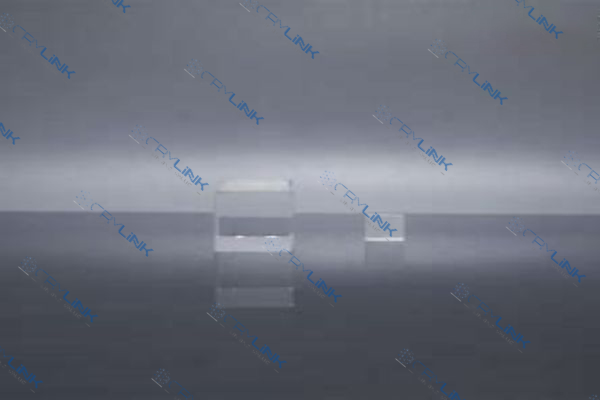
Ytterbium-Doped Potassium Yttrium Tungstate (Yb:KYW)
Ytterbium-Doped Potassium Yttrium Tungstate, better known as Yb:KYW, holds its own in the arena of ultrashort pulse generation. Like its counterpart Yb:KGW, Yb:KYW exhibits high thermal conductivity, a characteristic instrumental in managing the heat generated during high-power operations. This exceptional thermal property not only improves the overall efficiency of laser systems but also enhances their reliability, making Yb:KYW suitable for demanding laser applications.
The emission cross-section of Yb:KYW, albeit narrower than Yb:KGW, is amply sufficient for the generation of ultrashort pulses. This ability to generate pulses with durations in the femtosecond range marks Yb:KYW as a robust contender in the domain of ultrashort pulse generation. By creating a conducive environment for femtosecond laser pulses, Yb:KYW ensures high precision and effectiveness in applications requiring such pulses.
In terms of performance, Yb:KYW is on par with Yb:KGW when it comes to output power. Given the same pumping conditions, both Yb:KYW and Yb:KGW can deliver similarly high output powers. This performance parity can be largely attributed to their shared high thermal conductivity and pump-to-signal conversion efficiency.
However, Yb:KYW does have a slightly narrower tunability range when compared to Yb:KGW. Its tunability typically centers around 1040-1050 nm, which, although narrow, still supports a variety of applications. While the tunability range is an important consideration in laser design, the slightly narrower tunability of Yb:KYW does not significantly undermine its utility in most laser systems.
In conclusion, Yb:KYW is a noteworthy lasing medium in the realm of ultrashort pulse generation. Its high thermal conductivity, capable emission cross-section, and comparable output power make it a robust contender. Despite a slightly narrower tunability range, Yb:KYW continues to deliver reliable and efficient performance in laser systems.
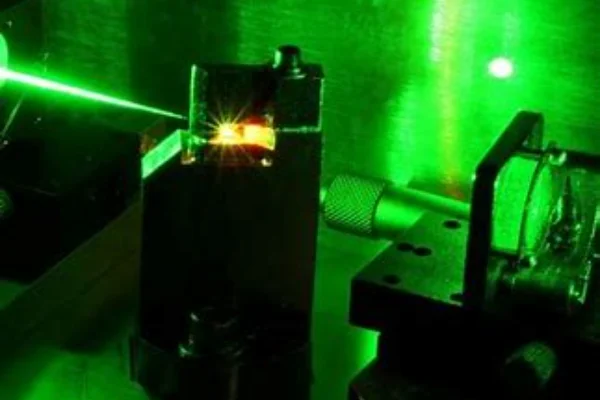
Comparative Analysis: Pulse Duration, Output Power, and Tunability
Ultrashort pulse generation, a prominent aspect of modern laser technology, plays a pivotal role in many fields including scientific research, industrial applications, and medical treatments. The generation of ultrashort pulses depends significantly on the lasing medium employed. Consequently, the selection of a suitable lasing medium is paramount to optimizing the output of ultrashort pulse lasers. To understand this better, we delve into a detailed comparative analysis of three popular laser crystals used as lasing media – Ti:sapphire, Yb:KGW, and Yb:KYW.
Starting with Ti:sapphire, it has garnered attention as a versatile lasing medium owing to its broad tunability and capability to support ultrashort pulse generation. Ti:sapphire exhibits an extensive gain bandwidth, which forms the bedrock of ultrashort pulse generation. The crystal is tuned over a wide range from 650 nm to 1100 nm, demonstrating its remarkable tunability. However, the performance of Ti:sapphire comes at the expense of substantial pump power and poses challenges related to thermal management. Despite these challenges, Ti:sapphire systems successfully generate high pulse repetition rates and considerable output power.
Transitioning from Ti:sapphire, Yb:KGW comes into the picture. This laser crystal bears significant thermal conductivity, thus rendering it apt for high-power applications. It exhibits a wide emission cross-section, which not only enables ultrashort pulse generation but also results in a higher pump-to-signal conversion efficiency than Ti:sapphire. From a performance perspective, Yb:KGW surpasses Ti:sapphire in output power under the same pumping conditions due to its superior thermal conductivity. However, its tunability is somewhat confined compared to Ti:sapphire, with a range from 1020 nm to 1060 nm.
Complementing Yb:KGW is Yb:KYW, another laser crystal of interest in ultrashort pulse generation. It shares a common trait with Yb:KGW in terms of high thermal conductivity. Though its emission cross-section is narrower than Yb:KGW, it is adequate for ultrashort pulse generation. The performance of Yb:KYW aligns with Yb:KGW concerning output power but bears a slightly narrower tunability range, typically around 1040-1050 nm.
After gaining insights into the individual characteristics of Ti:sapphire, Yb:KGW, and Yb:KYW, a comparative perspective is essential. Pulse duration, output power, and tunability form the core of this comparison.
Pulse duration is crucial in ultrashort pulse generation. Ti:sapphire systems shine in this aspect as they can produce pulses as short as a few femtoseconds. In contrast, Yb:KGW and Yb:KYW lasers typically generate pulses in the picosecond to femtosecond range.
In the output power context, Yb:KGW and Yb:KYW lead the way, surpassing Ti:sapphire, especially considering the same pump power. Their excellence in output power is attributed to their higher pump-to-signal conversion efficiency and impressive thermal properties.
Tunability is another parameter where Ti:sapphire outperforms both Yb:KGW and Yb:KYW. With an unrivaled tunability range, Ti:sapphire holds a key advantage in various applications. However, despite narrower tuning ranges, Yb:KGW and Yb:KYW hold their ground due to their power performance and stability.
In conclusion, the choice between Ti:sapphire, Yb:KGW, and Yb:KYW for ultrashort pulse generation is not black-and-white. It requires a careful understanding of the trade-offs between pulse duration, output power, and tunability. While Ti:sapphire stands out with the broadest tunability and shortest pulses, Yb:KGW, and Yb:KYW outperform it in terms of output power. The final decision rests on the specific requirements of the application at hand, underscoring the importance of a detailed understanding of these laser crystals.
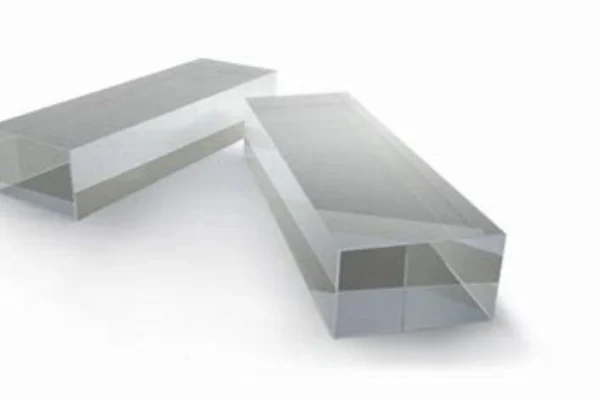
Conclusion
Choosing between Ti:sapphire, Yb:KGW, and Yb:KYW for ultrashort pulse generation requires an understanding of the trade-offs between pulse duration, output power, and tunability. While Ti:sapphire offers the broadest tunability and shortest pulses, Yb:KGW and Yb:KYW offer superior output power. Ultimately, the choice of laser crystal depends on the specific requirements of the application at hand.
Frequently Asked Questions
- 1. Why is Ti:sapphire widely used in ultrashort pulse lasers?
- Ti:sapphire is favored due to its large gain bandwidth that supports ultrashort pulse generation and its broad tunability.
- 2. What makes Yb:KGW and Yb:KYW suitable for high-power applications?
- Both Yb:KGW and Yb:KYW exhibit high thermal conductivity, which makes them suitable for high-power applications.
- 3. How does the tunability of Ti:sapphire compare to Yb:KGW and Yb:KYW?
- Ti:sapphire has a much broader tunability range compared to Yb:KGW and Yb:KYW.
- 4. Which laser crystal has the shortest pulse duration?
- Ti:sapphire systems can produce the shortest pulses, reaching down to a few femtoseconds.
- 5. Which laser crystal offers the highest output power?
- Yb:KGW and Yb:KYW can deliver higher output powers than Ti:sapphire under the same pumping conditions.


